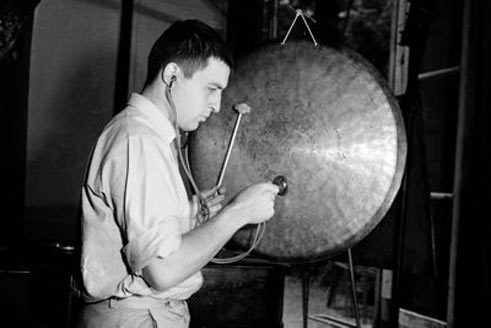CTM Festival
Artificial paradise between electronics and acoustics

Electronic music lives from the promise of a utopia: sounds created from electricity typically point to a world far removed from the familiar-sounding reality; they are an artificial paradise for the ears. This is especially true of the productions of experimental underground musicians and sound artists. The annual CTM (Club Transmediale) Festival in Berlin serves as a gathering point for their “adventurous music”.
For some years now Berlin can lay claim to being the world capital of electronic music, where, alongside techno and related forms of club music, diverse freer varieties that cannot be danced to have established themselves. In the grey zone between club and experiment moves the programme of the CTM Festival, which was first organised in 1999 as a musical supporting programme of the Transmediale Media Art Festival. Now the CTM has taken on a life of its own and established itself as one of the most important international festivals for free experimental music. With great consistency, it cultivates the border-crossings between advanced dance music, eardrum-punishing drone noise and quieter sound experiments: this year visitors could experience the young Hamburg techno producer Helena Hauff, the Anglo-American duo KTL, feared for its booming bass frequencies, and the finely-knit musique concrete of the Groupe de rechereche musicales (GRM) of the academic Paris Electro-Acoustics Institute.
Roots in the nineties
“Dis Continuity” was the theme of the CTM’s 15th anniversary, pointing to the complex relationship in which past and present experimental approaches stand to each other. There are sometimes also complicated continuities and discontinuities even within the biographies of individual musicians. Thus the transitions from techno to freer directions can be very fluid. The most prominent example is that of the former duo of Mark Ernestus and Moritz von Oswald. In the 1990s they become known through their influential label Basic Channel; their music was marked by the reduction of techno to its raucous rudiments and to precise reverb effects. One important influence was Jamaican dub reggae, in which the individual tracks of reggae songs are isolated and alienated.For several years now the two musicians have gone their separate ways. Their present projects, which could be heard at the CTM, stand in clear contrast to their club past: the Moritz von Oswald Trio, which plays in Berghain, may be seen as a less formally strict continuation of the dub approach. Von Oswald takes the sounds of the participating musicians as material that he then processes in real-time on the mixer and condenses into a reverberating meshwork. On stage next to von Oswald’s partner Max Loderbauer at the CTM concert sat the Nigerian drummer Tony Allen, one of the greatest instrumentalists of Afrobeat.
Links to world music and jazz
Mark Ernestus, on the other hand, has focused for several years on the production of African music; his current project, Jeri-Jeri, is made up of Senegalese mbalax musicians who are for the most part percussionists. Their rhythmically highly complex music may have at first glance little connection to Ernestus’s beginnings, yet you could easily recognize at their performance at the Stattbad Wedding, a converted public baths, that the polyrhythms of Jeri-Jeri are based on patterns that are varied and re-linked – as in techno, if in another beat.A guest of the festival was a representative of the old pioneer generation, the jazz musician Charles Cohen from Philadelphia. He has more or less materially preserved the spirit of optimism that prevailed in the early days of sound synthesis: for decades he has worked with the m Buchla Music Easel, a rare synthesizer from the 1960s, developed by synthesizer pioneer Don Buchla. Cohen’s spartan approach is a moving testament to the wealth that can grow out of creative self-restriction: with a single device, he generated a spontaneous energy and colour that came as close to the utopian promise of electronic music as did any other concert at the festival.
Working hypothesis: progress through technology
Another traditional strand of experimental music that forms a constant at the CTM is electro-acoustic music. In it electronic and acoustic sounds are either combined directly or acoustic instruments are processed electronically. The British band Cyclobe has dedicated itself to this blending of heterogeneous sound sources; their computer and synthesizer sounds, using hurdy-gurdy and bagpipes, bundled the mix into a hallucinogenic ritual music with magical effect at the Theater Hebbel am Ufer. In the words of Stephen Throwers, who together with Ossian Brown founded Cyclobe in 1990s: “Our ideal is a mix of purely electronic and instrumental sounds, so that somewhere in the middle of a piece you don’t know any longer whether you’re hearing real instruments or pure electronics”.“Pure” electronics, as is embodied, for example, by the type of the laptop musician, is also an integral part of the CTM canon, often in conjunction with visual media. Robert Henke, who appeared at the close of the festival in the House of World Cultures, is in many ways the laptop musician par excellence. “Robert Henke was already playing at our festival in 1999”, says Jan Rohlf, artistic director of the CTM. The sound artist, who became known for his minimalist techno under the name of Monolake, has also written programmer music history: Henke is one of the developers of Ableton Live, one of the most frequently used music programmes ever. In addition, he is Professor of Sound Design at the Berlin University of the Arts. In his performance Lumière, he used blazingly bright lasers that were synchronized to the music. Henke’s fusion of abstract techno and geometrical forms such as squares and circles aimed at audio-visual synergy. You have to ask yourself, however, whether the flaunting of this progress-through-technology attitude is not itself already somewhat old-fashioned – and how much remains of its erstwhile utopian promise.